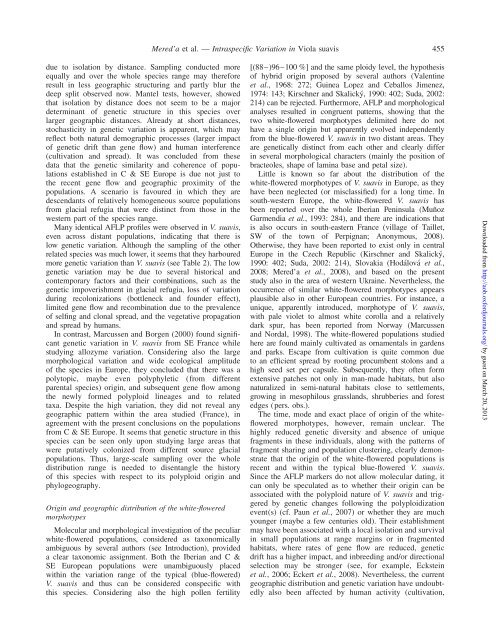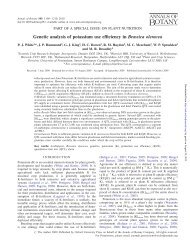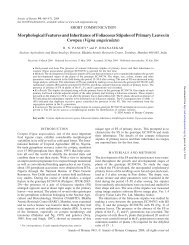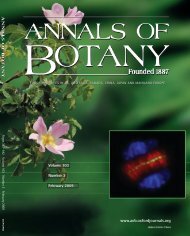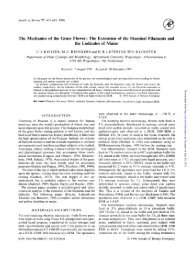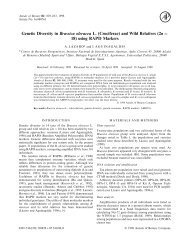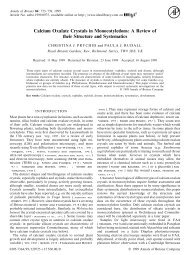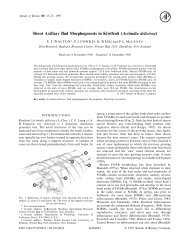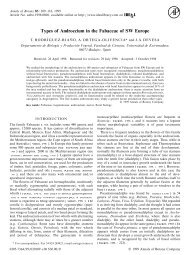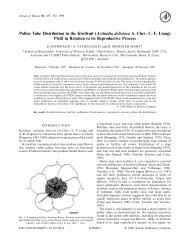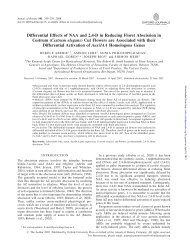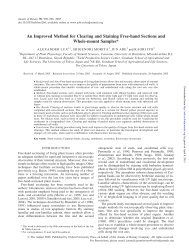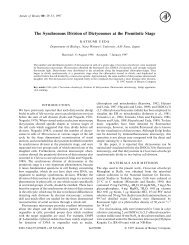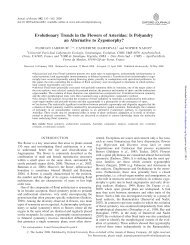Intraspecific Variation in Viola suavis in Europe ... - Annals of Botany
Intraspecific Variation in Viola suavis in Europe ... - Annals of Botany
Intraspecific Variation in Viola suavis in Europe ... - Annals of Botany
Create successful ePaper yourself
Turn your PDF publications into a flip-book with our unique Google optimized e-Paper software.
due to isolation by distance. Sampl<strong>in</strong>g conducted more<br />
equally and over the whole species range may therefore<br />
result <strong>in</strong> less geographic structur<strong>in</strong>g and partly blur the<br />
deep split observed now. Mantel tests, however, showed<br />
that isolation by distance does not seem to be a major<br />
determ<strong>in</strong>ant <strong>of</strong> genetic structure <strong>in</strong> this species over<br />
larger geographic distances. Already at short distances,<br />
stochasticity <strong>in</strong> genetic variation is apparent, which may<br />
reflect both natural demographic processes (larger impact<br />
<strong>of</strong> genetic drift than gene flow) and human <strong>in</strong>terference<br />
(cultivation and spread). It was concluded from these<br />
data that the genetic similarity and coherence <strong>of</strong> populations<br />
established <strong>in</strong> C & SE <strong>Europe</strong> is due not just to<br />
the recent gene flow and geographic proximity <strong>of</strong> the<br />
populations. A scenario is favoured <strong>in</strong> which they are<br />
descendants <strong>of</strong> relatively homogeneous source populations<br />
from glacial refugia that were dist<strong>in</strong>ct from those <strong>in</strong> the<br />
western part <strong>of</strong> the species range.<br />
Many identical AFLP pr<strong>of</strong>iles were observed <strong>in</strong> V. <strong>suavis</strong>,<br />
even across distant populations, <strong>in</strong>dicat<strong>in</strong>g that there is<br />
low genetic variation. Although the sampl<strong>in</strong>g <strong>of</strong> the other<br />
related species was much lower, it seems that they harboured<br />
more genetic variation than V. <strong>suavis</strong> (see Table 2). The low<br />
genetic variation may be due to several historical and<br />
contemporary factors and their comb<strong>in</strong>ations, such as the<br />
genetic impoverishment <strong>in</strong> glacial refugia, loss <strong>of</strong> variation<br />
dur<strong>in</strong>g recolonizations (bottleneck and founder effect),<br />
limited gene flow and recomb<strong>in</strong>ation due to the prevalence<br />
<strong>of</strong> self<strong>in</strong>g and clonal spread, and the vegetative propagation<br />
andspreadbyhumans.<br />
In contrast, Marcussen and Borgen (2000) found significant<br />
genetic variation <strong>in</strong> V. <strong>suavis</strong> from SE France while<br />
study<strong>in</strong>g allozyme variation. Consider<strong>in</strong>g also the large<br />
morphological variation and wide ecological amplitude<br />
<strong>of</strong> the species <strong>in</strong> <strong>Europe</strong>, they concluded that there was a<br />
polytopic, maybe even polyphyletic (from different<br />
parental species) orig<strong>in</strong>, and subsequent gene flow among<br />
the newly formed polyploid l<strong>in</strong>eages and to related<br />
taxa. Despite the high variation, they did not reveal any<br />
geographic pattern with<strong>in</strong> the area studied (France), <strong>in</strong><br />
agreement with the present conclusions on the populations<br />
from C & SE <strong>Europe</strong>. It seems that genetic structure <strong>in</strong> this<br />
species can be seen only upon study<strong>in</strong>g large areas that<br />
were putatively colonized from different source glacial<br />
populations. Thus, large-scale sampl<strong>in</strong>g over the whole<br />
distribution range is needed to disentangle the history<br />
<strong>of</strong> this species with respect to its polyploid orig<strong>in</strong> and<br />
phylogeography.<br />
Orig<strong>in</strong> and geographic distribution <strong>of</strong> the white-flowered<br />
morphotypes<br />
Molecular and morphological <strong>in</strong>vestigation <strong>of</strong> the peculiar<br />
white-flowered populations, considered as taxonomically<br />
ambiguous by several authors (see Introduction), provided<br />
a clear taxonomic assignment. Both the Iberian and C &<br />
SE <strong>Europe</strong>an populations were unambiguously placed<br />
with<strong>in</strong> the variation range <strong>of</strong> the typical (blue-flowered)<br />
V. <strong>suavis</strong> and thus can be considered conspecific with<br />
this species. Consider<strong>in</strong>g also the high pollen fertility<br />
Mered’a et al. — <strong>Intraspecific</strong> <strong>Variation</strong> <strong>in</strong> <strong>Viola</strong> <strong>suavis</strong> 455<br />
[(88–)96–100 %] and the same ploidy level, the hypothesis<br />
<strong>of</strong> hybrid orig<strong>in</strong> proposed by several authors (Valent<strong>in</strong>e<br />
et al., 1968: 272; Gu<strong>in</strong>ea Lopez and Ceballos Jimenez,<br />
1974: 143; Kirschner and Skalicky´, 1990: 402; Suda, 2002:<br />
214) can be rejected. Furthermore, AFLP and morphological<br />
analyses resulted <strong>in</strong> congruent patterns, show<strong>in</strong>g that the<br />
two white-flowered morphotypes delimited here do not<br />
have a s<strong>in</strong>gle orig<strong>in</strong> but apparently evolved <strong>in</strong>dependently<br />
from the blue-flowered V. <strong>suavis</strong> <strong>in</strong> two distant areas. They<br />
are genetically dist<strong>in</strong>ct from each other and clearly differ<br />
<strong>in</strong> several morphological characters (ma<strong>in</strong>ly the position <strong>of</strong><br />
bracteoles, shape <strong>of</strong> lam<strong>in</strong>a base and petal size).<br />
Little is known so far about the distribution <strong>of</strong> the<br />
white-flowered morphotypes <strong>of</strong> V. <strong>suavis</strong> <strong>in</strong> <strong>Europe</strong>, as they<br />
have been neglected (or misclassified) for a long time. In<br />
south-western <strong>Europe</strong>, the white-flowered V. <strong>suavis</strong> has<br />
been reported over the whole Iberian Pen<strong>in</strong>sula (Muñoz<br />
Garmendia et al., 1993: 284), and there are <strong>in</strong>dications that<br />
is also occurs <strong>in</strong> south-eastern France (village <strong>of</strong> Taillet,<br />
SW <strong>of</strong> the town <strong>of</strong> Perpignan; Anonymous, 2008).<br />
Otherwise, they have been reported to exist only <strong>in</strong> central<br />
<strong>Europe</strong> <strong>in</strong> the Czech Republic (Kirschner and Skalicky´,<br />
1990: 402; Suda, 2002: 214), Slovakia (Hodálová et al.,<br />
2008; Mered’a et al., 2008), and based on the present<br />
study also <strong>in</strong> the area <strong>of</strong> western Ukra<strong>in</strong>e. Nevertheless, the<br />
occurrence <strong>of</strong> similar white-flowered morphotypes appears<br />
plausible also <strong>in</strong> other <strong>Europe</strong>an countries. For <strong>in</strong>stance, a<br />
unique, apparently <strong>in</strong>troduced, morphotype <strong>of</strong> V. <strong>suavis</strong>,<br />
with pale violet to almost white corolla and a relatively<br />
dark spur, has been reported from Norway (Marcussen<br />
and Nordal, 1998). The white-flowered populations studied<br />
here are found ma<strong>in</strong>ly cultivated as ornamentals <strong>in</strong> gardens<br />
and parks. Escape from cultivation is quite common due<br />
to an efficient spread by root<strong>in</strong>g procumbent stolons and a<br />
high seed set per capsule. Subsequently, they <strong>of</strong>ten form<br />
extensive patches not only <strong>in</strong> man-made habitats, but also<br />
naturalized <strong>in</strong> semi-natural habitats close to settlements,<br />
grow<strong>in</strong>g <strong>in</strong> mesophilous grasslands, shrubberies and forest<br />
edges (pers. obs.).<br />
The time, mode and exact place <strong>of</strong> orig<strong>in</strong> <strong>of</strong> the whiteflowered<br />
morphotypes, however, rema<strong>in</strong> unclear. The<br />
highly reduced genetic diversity and absence <strong>of</strong> unique<br />
fragments <strong>in</strong> these <strong>in</strong>dividuals, along with the patterns <strong>of</strong><br />
fragment shar<strong>in</strong>g and population cluster<strong>in</strong>g, clearly demonstrate<br />
that the orig<strong>in</strong> <strong>of</strong> the white-flowered populations is<br />
recent and with<strong>in</strong> the typical blue-flowered V. <strong>suavis</strong>.<br />
S<strong>in</strong>ce the AFLP markers do not allow molecular dat<strong>in</strong>g, it<br />
can only be speculated as to whether their orig<strong>in</strong> can be<br />
associated with the polyploid nature <strong>of</strong> V. <strong>suavis</strong> and triggered<br />
by genetic changes follow<strong>in</strong>g the polyploidization<br />
event(s) (cf. Paun et al., 2007) or whether they are much<br />
younger (maybe a few centuries old). Their establishment<br />
may have been associated with a local isolation and survival<br />
<strong>in</strong> small populations at range marg<strong>in</strong>s or <strong>in</strong> fragmented<br />
habitats, where rates <strong>of</strong> gene flow are reduced, genetic<br />
drift has a higher impact, and <strong>in</strong>breed<strong>in</strong>g and/or directional<br />
selection may be stronger (see, for example, Eckste<strong>in</strong><br />
et al., 2006; Eckert et al., 2008). Nevertheless, the current<br />
geographic distribution and genetic variation have undoubtedly<br />
also been affected by human activity (cultivation,<br />
Downloaded from<br />
http://aob.oxfordjournals.org/ by guest on March 20, 2013


